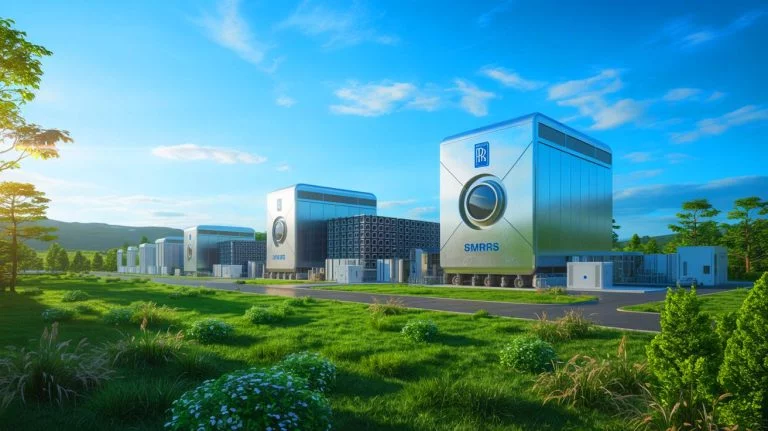| IN A NUTSHELL |
|
As the global demand for sustainable energy solutions continues to surge, the role of nuclear power in meeting these needs is becoming increasingly significant. Rolls-Royce, a prominent name in engineering and manufacturing, is at the forefront of this movement with its innovative Small Modular Reactor (SMR) technology. The company has embarked on a groundbreaking project to establish the first fleet of SMRs in the United Kingdom, aiming to deliver a substantial portion of the nation’s energy needs. This initiative is not just about energy production; it represents a strategic shift in how nuclear power plants are designed, built, and deployed, potentially setting a new standard in the industry.
Revolutionizing Nuclear Power with Modular Design
Rolls-Royce’s approach to nuclear energy involves a significant departure from traditional methods. The company’s SMR design emphasizes modular construction, where approximately 90% of each reactor is assembled under factory conditions. This method contrasts sharply with the conventional practice of on-site construction, which often leads to prolonged timelines and inflated costs. By prefabricating components, Rolls-Royce aims to streamline the construction process, significantly reducing the time and expense associated with building nuclear power plants.
This modular strategy necessitates a robust and diverse supply chain. To this end, Rolls-Royce has secured key partnerships, such as a multi-million-dollar agreement with Curtiss-Wright, a UK-based nuclear enterprise. This collaboration underscores the importance of reliable safety systems, as Curtiss-Wright will supply the Non-programmable Diverse Reactor Protection Systems. These systems are crucial for ensuring the reactors can be safely shut down, relying on proven electronic technology rather than complex programmable devices.
Strengthening International Collaborations
The success of Rolls-Royce’s SMR program hinges on the strength of its international collaborations. The recent memorandum of understanding with Czech company Škoda JS is a testament to this global approach. This partnership will explore the production of essential components for the SMR program, highlighting the growing interdependence of global supply chains in the nuclear sector. Additionally, Rolls-Royce has engaged with another Czech entity, ÚJV Řež, for the critical analysis and testing of SMR components.
These collaborations are not solely about manufacturing capabilities. They also foster a sharing of technological expertise and innovation, which is crucial for the advancement of SMR technology. By leveraging international partnerships, Rolls-Royce positions itself not only as a leader in nuclear technology but also as a pioneer in creating a more integrated and efficient global energy landscape.
The Impact of SMRs on the UK’s Energy Landscape
The introduction of SMRs is poised to have a transformative effect on the UK’s energy sector. Each Rolls-Royce SMR is designed to generate 470 megawatts of low-carbon energy, equating to the output of more than 150 onshore wind turbines. This capability is crucial as the UK seeks to expand its clean energy portfolio while reducing carbon emissions. With a projected operational lifespan of at least 60 years, these reactors promise long-term energy stability and affordability.
Moreover, the SMR initiative aligns with the UK’s broader energy strategy, aiming to enhance energy security and reduce reliance on fossil fuels. By generating enough electricity to power approximately 3 million homes, Rolls-Royce’s SMRs represent a significant step towards achieving these national energy goals. The project not only highlights the potential of SMRs to meet domestic energy demands but also positions the UK as a leader in next-generation nuclear technology.
Looking Ahead: The Future of SMR Technology
As Rolls-Royce moves forward with its SMR program, the company is poised to play a pivotal role in shaping the future of nuclear energy. With a strategic advantage in the European regulatory landscape, Rolls-Royce is well-positioned to lead the charge in SMR technology, both domestically and globally. The company’s commitment to innovation and sustainability is evident in its approach to reactor design and construction.
Rolls-Royce’s first-mover advantage in the SMR market underscores its potential to become a world leader in this field. This status could lead to significant export opportunities, enhancing the UK’s position as a premier green technology exporter. As the global energy landscape continues to evolve, the role of SMRs will likely become increasingly central to meeting the world’s energy needs sustainably and efficiently.
The strides made by Rolls-Royce in developing SMRs highlight a pivotal moment in the transition to cleaner energy solutions. As these technologies advance, they raise important questions about the future of energy production worldwide. How will the integration of SMRs redefine the global energy landscape, and what challenges and opportunities will arise as nations seek to balance innovation with sustainability?
Did you like it? 4.4/5 (23)








Is this really safe? I’ve heard horror stories about nuclear power! 😱
How soon can we expect these reactors to be up and running?
Rolls-Royce in nuclear? That’s a plot twist I didn’t see coming. 🤔
Thank you for shedding light on this complex topic. Very informative!
But what about the nuclear waste? That’s always been a problem, hasn’t it?
Are these SMRs going to be placed in populated areas? Seems risky!
Can we trust Rolls-Royce to manage nuclear reactors safely?
Sounds like a game-changer for clean energy! 🌍
What happens if there’s a meltdown? Are these reactors meltdown-proof?
How will this impact energy bills? Will they go down or up?